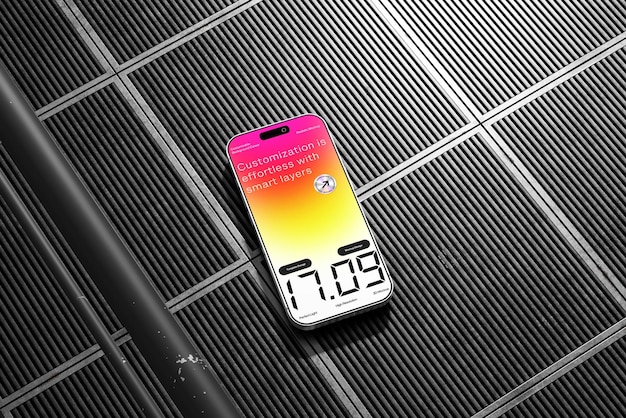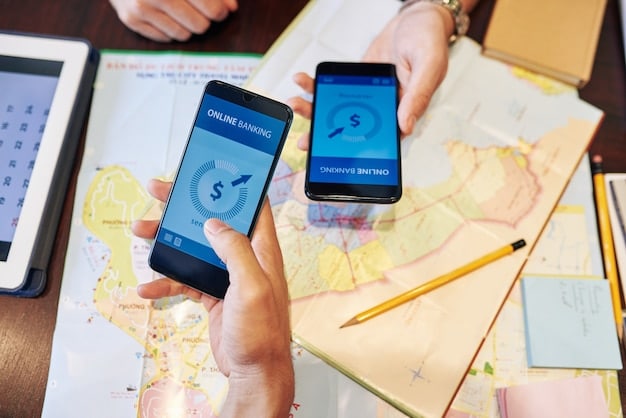Maximize Smartphone Battery Life: Insider Tips for 30% Boost

Advertisements
Maximize your smartphone’s battery life by up to 30% using these insider tips, including optimizing screen settings, managing background apps, and understanding battery health.
Is your smartphone battery constantly draining faster than you’d like? Discover how to maximize your smartphone’s battery life by 30% with these insider tips, ensuring your device stays powered throughout the day.
Advertisements
Understand Your Battery’s Health
Understanding your smartphone battery’s health is crucial for optimizing its lifespan. Batteries degrade over time due to charge cycles and extreme temperatures. By monitoring its condition, you can implement practices to slow down this degradation.
Let’s look at indicators and some preventative measures that can really make a difference with your phone’s health.
Advertisements
Checking Battery Health
Most smartphones offer built-in tools to check battery health. For iPhones, go to Settings > Battery > Battery Health. Android users can often find this information in Settings > Battery > Battery Health and Charging. These tools provide insights into the battery’s maximum capacity and overall condition.
Interpreting the Data
Pay attention to the “Maximum Capacity” percentage on iPhones or the equivalent metric on Android. A lower percentage indicates that the battery’s ability to hold a charge has decreased. Understanding this number helps you gauge when it might be time to consider battery replacement or adjust usage habits.
- Avoid Extreme Temperatures: High heat accelerates battery degradation. Don’t leave your phone in direct sunlight or hot cars.
- Use Optimized Charging: Enable features like “Optimized Battery Charging” on iPhones, which learns your charging habits to reduce battery aging.
- Minimize Deep Discharges: Avoid letting your battery frequently drop below 20%. Partial charges are better for long-term battery health.
Monitoring and managing your battery’s health proactively extends its lifespan and ensures reliable performance. Small changes in charging and usage habits make a huge difference over time.

Optimize Screen Settings
Optimizing screen settings is one of the most effective ways to reduce battery consumption on your smartphone. The screen is often the biggest power drain, so even small adjustments can significantly extend battery life.
Brightness, timeout and resolution will all have an effect on battery.
Adjust Screen Brightness
Lowering screen brightness reduces the amount of power needed to illuminate the display. Most smartphones have an adaptive brightness setting that automatically adjusts brightness based on ambient light. While convenient, manually lowering the brightness can save even more energy.
Shorten Screen Timeout
The screen timeout setting determines how long the screen stays on after you stop interacting with your phone. Shortening this duration ensures that the screen turns off quickly when not is use, preventing unnecessary battery drain. A timeout of 30 seconds or less is recommended for optimal battery savings.
Disable Auto-Brightness in Direct Sunlight
While auto-brightness is useful indoors, direct sunlight can cause it to crank the brightness to 100%, decimating battery life. It’s often better to manually adjust in this scenario.
- Reduce Refresh Rate: Some phones have the option to run 120Hz which makes the screen smoother, but also uses more battery. Switching to 60Hz could save a considerable amount of battery life.
- Turn off Ambient Display: Ambient display is a function that turns on the screen to show a notification. Turn this off for further power savings.
- Use Dark Mode: Activate dark mode or night mode in your phone’s settings. Dark themes use less power because they reduce the amount of light emitted by the screen, especially on OLED displays.
Adjusting screen brightness and timeout settings are simple yet effective strategies to dramatically increase your smartphone’s battery life. Combine these techniques with dark mode for even greater energy savings.
Manage Background App Refresh
Managing background app refresh is essential for preventing apps from draining battery life when they’re not actively in use. Many apps continue to run in the background, consuming power and data even when you’re not using them.
Let’s dive into how to manage this and save some energy.
Disable Unnecessary Background App Refresh
Turn off background app refresh for apps that don’t need to update in real-time. On iPhones, go to Settings > General > Background App Refresh. On Android, you can usually find this setting in Settings > Battery > Battery Optimization.
- Choose Apps Wisely: Identify apps that constantly refresh in the background and toggle them off. Social media, email, and news apps are common culprits.
- Manual Updates: Instead of automatic background refresh, manually update these apps when needed to conserve battery.
- Force Stop Apps: If an app is excessively draining power, force stop it from the app settings.
Optimizing App Usage
Limit the number of apps allowed to run in the background. This prevents excessive power consumption and ensures that only necessary apps are using battery when you’re not actively using them.
By carefully managing background app refresh, you can significantly reduce battery drain and extend the time between charges. Regularly review your app settings to ensure optimal battery performance.
Disable Location Services When Not Needed
Location services can be a major battery drain, as apps constantly use GPS or Wi-Fi to track your location. Disabling location services when they’re not needed can significantly extend your smartphone’s battery life.
Here’s some suggestions to keep your usage minimal.
Limit Location Access
Review which apps have access to your location and adjust the permissions to “While Using the App” or “Never” for those that don’t require constant location tracking. On iPhones, go to Settings > Privacy > Location Services. On Android, find these settings in Settings > Location > App permissions.
Turn Off Location Sharing
Disable location sharing features in apps like social media and messaging platforms if you don’t need to share your location with others. Constant location sharing consumes considerable battery power.
- Use Wi-Fi Instead of GPS: When possible, rely on Wi-Fi for location services, as it uses less energy than GPS.
- Disable Location-Based Alerts: Some apps use location services to send alerts based on your location. Disable these alerts if they’re not essential.
- Airplane Mode: In areas with weak cell signals, your phone works harder to maintain connectivity, draining the battery. Switching to airplane mode stops this.
By managing location services effectively, you can minimize battery drain and ensure longer usage times between charges. Regularly check your app permissions and disable unnecessary location access to preserve battery life.

Turn Off Unnecessary Connectivity Features
Connectivity features like Bluetooth, Wi-Fi, and NFC can consume battery power even when not actively in use. Turning off these features when they’re not needed can help extend your smartphone’s battery life.
Here’s how to do this.
Disable Bluetooth When Not in Use
Bluetooth is often left on for connecting to wireless headphones, speakers, or other devices. However, when not actively connected, Bluetooth continues to search for devices, draining battery. Turn off Bluetooth in Settings when not needed.
Manage Wi-Fi Connectivity
When Wi-Fi is enabled, your phone constantly searches for available networks. If you’re in an area with no Wi-Fi or have limited access. It’s time to turn it off!
Disable NFC When Not Needed
Near Field Communication (NFC) is used for contactless payments and data transfer. If you rarely use NFC, disable it in Settings to prevent unnecessary battery consumption.
- Airplane Mode in Low Signal Areas: As mentioned earlier, weak cell signals cause your phone to work harder, draining the battery, use airplane mode.
- Selective Syncing: You don’t need to sync all of these all of the time. Some things you will only need to do when connected to Wi-Fi.
By turning off unused connectivity features, can substantially reduce battery drain. Make it a habit to disable Bluetooth, Wi-Fi, and NFC when they’re not required, and take advantage of airplane mode in areas with poor reception to maximize battery life.
Keep Your Software Updated
Keeping your smartphone’s software updated is not only important for security but also for optimizing battery life. Software updates often include bug fixes, performance improvements, and energy efficiency enhancements.
A lot goes into updates so it’s a great idea to keep everything up-to-date.
Install Updates Promptly
Check for software updates regularly and install them as soon as they become available. Software updates can also include specific optimizations for battery usage, improving overall efficiency.
Software updates are released by manufacturers to address various issues, including battery-related problems. These updates can include power management improvements, bug fixes, and new features that enhance energy efficiency.
- Optimized Battery Usage: Software updates often bring new features and tweaks that reduce the amount of power consumed by apps and system processes.
- Performance Enhancements: Keeping software updated can also improve overall device performance, which indirectly helps battery life. A smoother, more efficient phone uses less energy.
By keeping your smartphone’s software updated, you ensure access to the latest battery optimizations and performance improvements. Regularly check for updates and install them promptly to maximize battery life.
| Key Point | Brief Description |
|---|---|
| 🔋 Battery Health | Monitor health and avoid extreme temperatures. |
| 🔆 Screen Settings | Lower brightness and reduce screen timeout. |
| 🚫 Background Apps | Disable unnecessary app refresh. |
| 📡 Connectivity | Turn off Bluetooth, Wi-Fi, and NFC when not in use. |
Frequently Asked Questions
▼
It’s generally recommended to avoid frequent full charging. Partial charges are better for battery health. Try to keep your battery between 20% and 80% for optimal performance.
▼
Fast charging can generate heat, which can degrade battery health over time. Use it sparingly and consider standard charging when time isn’t a constraint to minimize heat exposure.
▼
Most modern smartphones have protection circuits that stop charging when the battery is full. However, frequent overnight charging can still generate heat, so it’s best to avoid it if possible.
▼
Social media, games, and navigation apps tend to consume a lot of battery due to constant background activity, location services, and high screen usage. Manage their settings to limit drain.
▼
If your battery’s maximum capacity is significantly reduced, and you experience frequent shutdowns or charging issues, it might be time for a replacement. Consult a professional to assess the battery’s condition.
Conclusion
By implementing these insider tips, you can significantly maximize your smartphone’s battery life by 30% or more. Making small adjustments to your daily habits makes a big difference. With these simple tools you can ensure your smartphone stays powered throughout the day.